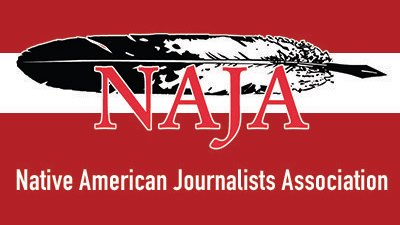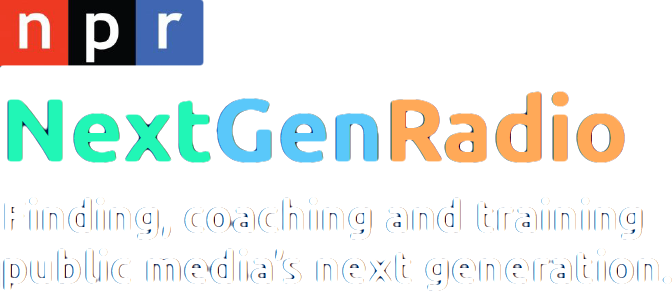
The impact of climate change
We are finding, coaching and training public media’s next generation. Five talented reporters are participating in a week-long state-of-the-art training program.
In this project we are highlighting the experiences of people whose lives are being affected by climate change.
Swinomish elder and Community Environmental Health Specialist Larry Campbell has worked for over a decade at the Swinomish Indian Tribal Community on the Indigenous Health Indicators project. Campbell seeks to integrate community needs into the tribe’s climate adaptation response
Illustration by Ard Su
“The dysfunctions are not ours”: Adapting to climate crisis with traditional ecological knowledge
“If our environment is going to be toxic, and it’s going to affect those resources, it’s going to affect the health of our people also,” Swinomish elder and environmental health specialist Larry Campbell said.
Campbell has worked for his tribe in historic preservation and community health for over three decades. He understood early on that a changing climate was impacting access to, and knowledge of, traditional foods within his community.
“25 years ago, I had elders from my community, and other tribal communities, who saw the work I was doing and they come and talk to me,” Campbell said. “They said, ‘We know where all those foods and medicines are, what they do, how to gather it, how to prepare it, but when we go there to look, they’re not there anymore. What happened to them?’”
The Swinomish Indian Tribal Community, a federally recognized tribe located in western Washington state along the Puget Sound, has worked vigorously to meet the challenges of climate change facing their coastal community. The tribe put forth a Climate Adaptation Action Plan in 2010, seeking to address the specific needs of the Swinomish people and environment.
“We decided to bypass the argument, ‘Is climate change real?’” Campbell said. “It is real, it’s here today, and let’s go right to action.”
Campbell is the Community Environmental Health Specialist at the Swinomish Indian Tribal Community. Since 2011, he’s led the Indigenous Health Indicators (IHI) project, working to create a more accurate conception of Indigenous well-being, encompassing individual, community, and ecological health. He and his team surveyed Swinomish community members to better understand their needs and perspectives.
LISTEN TO THE STORY
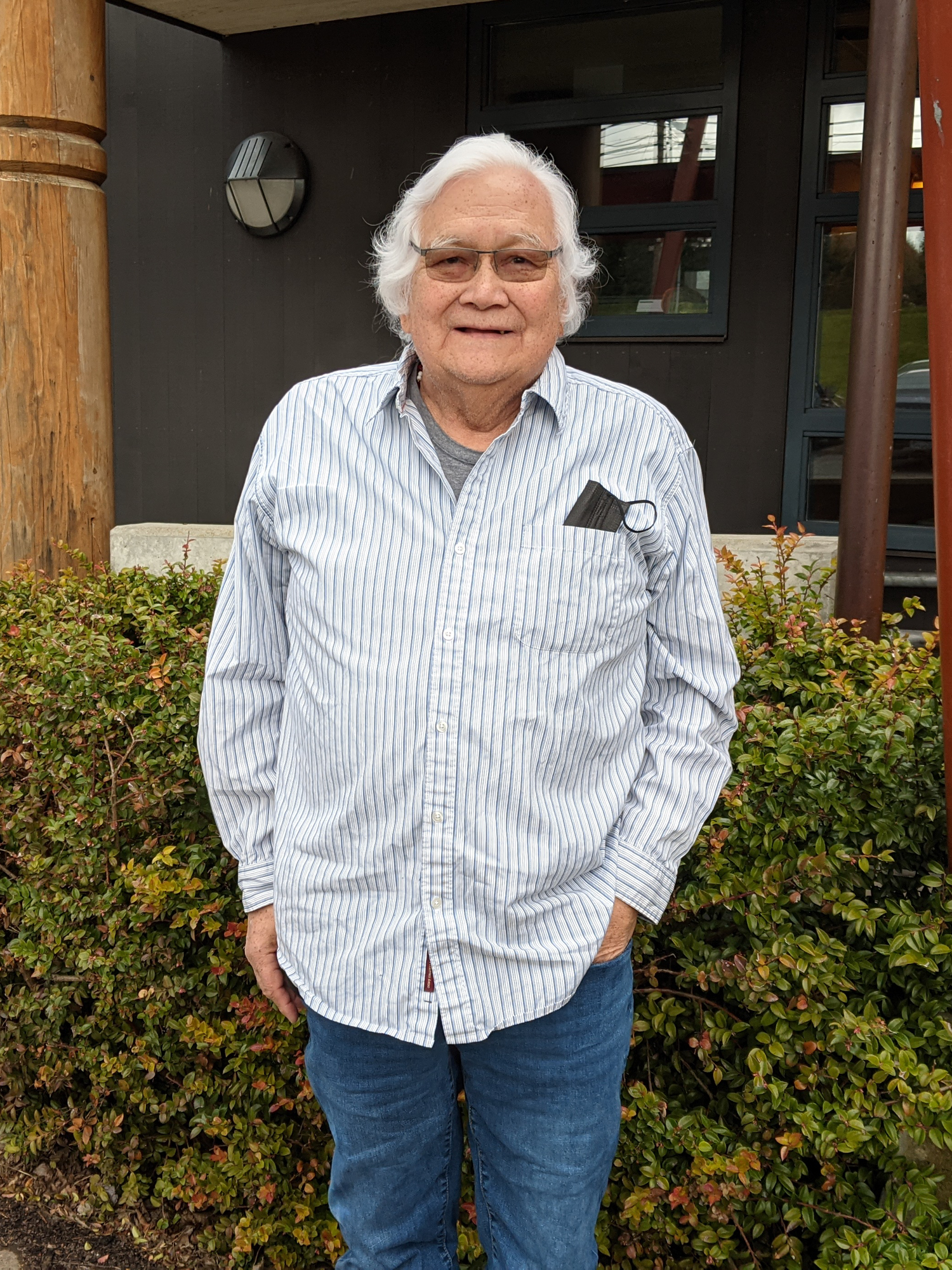
Larry Campbell served as Tribal Historic Preservation Officer for the Swinomish Indian Tribal Community for decades prior to his work on the Indigenous Health Indicators. (Photo by Nathan Abrams)
Through their research, the team identified community connection, natural resources security, cultural use, education, self-determination and resilience as indicators of health relevant to the Swinomish community.
“It’s a more holistic way of doing things rather than the linear western method,” Campbell said. “One of my long-term goals is to try to make a difference in the way that science is being conducted.”
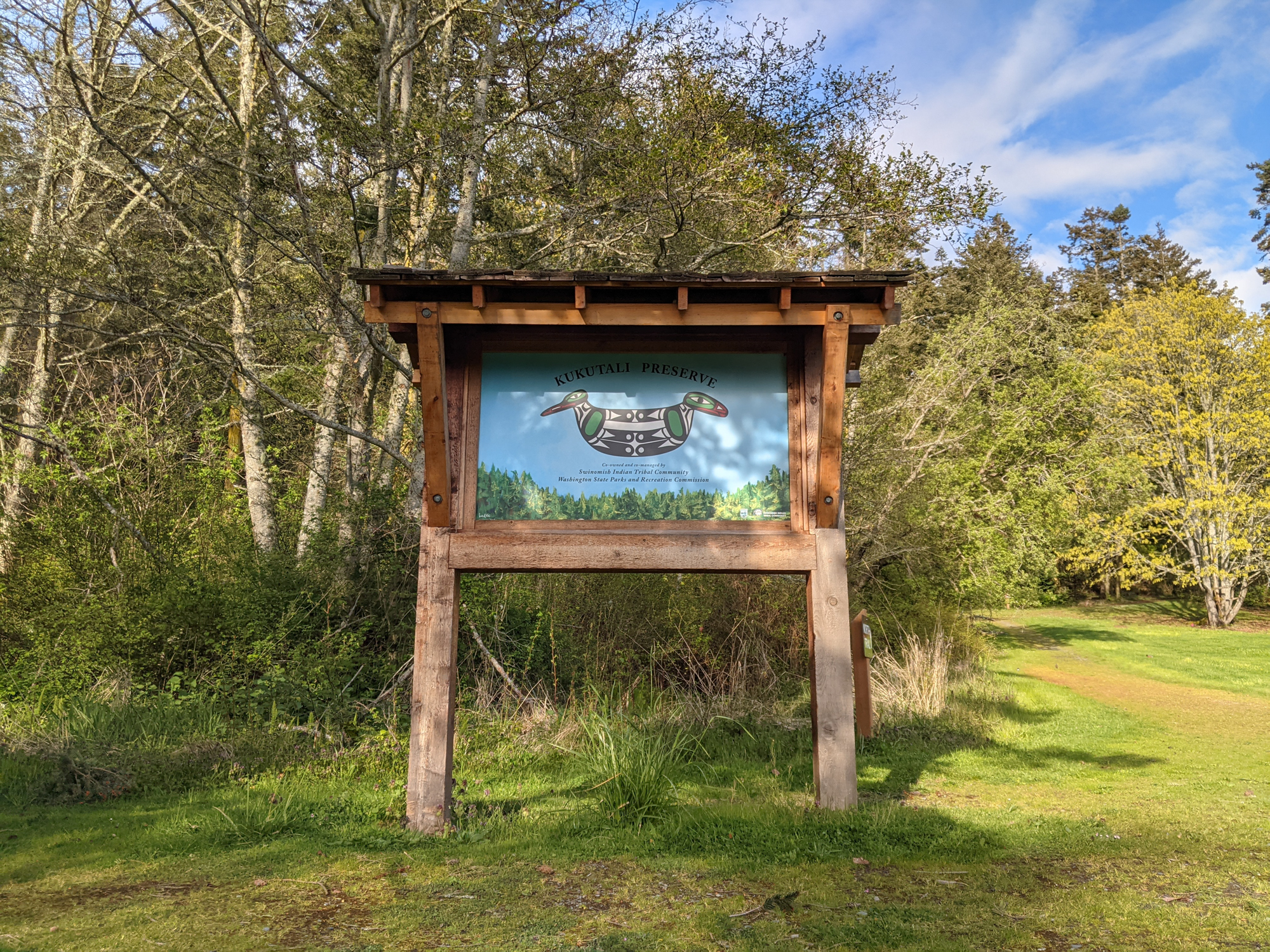
Kukutali Preserve, located on the Swinomish reservation, is co-managed by the Swinomish Indian Tribal Community and Washington State. (Photo by Nathan Abrams)
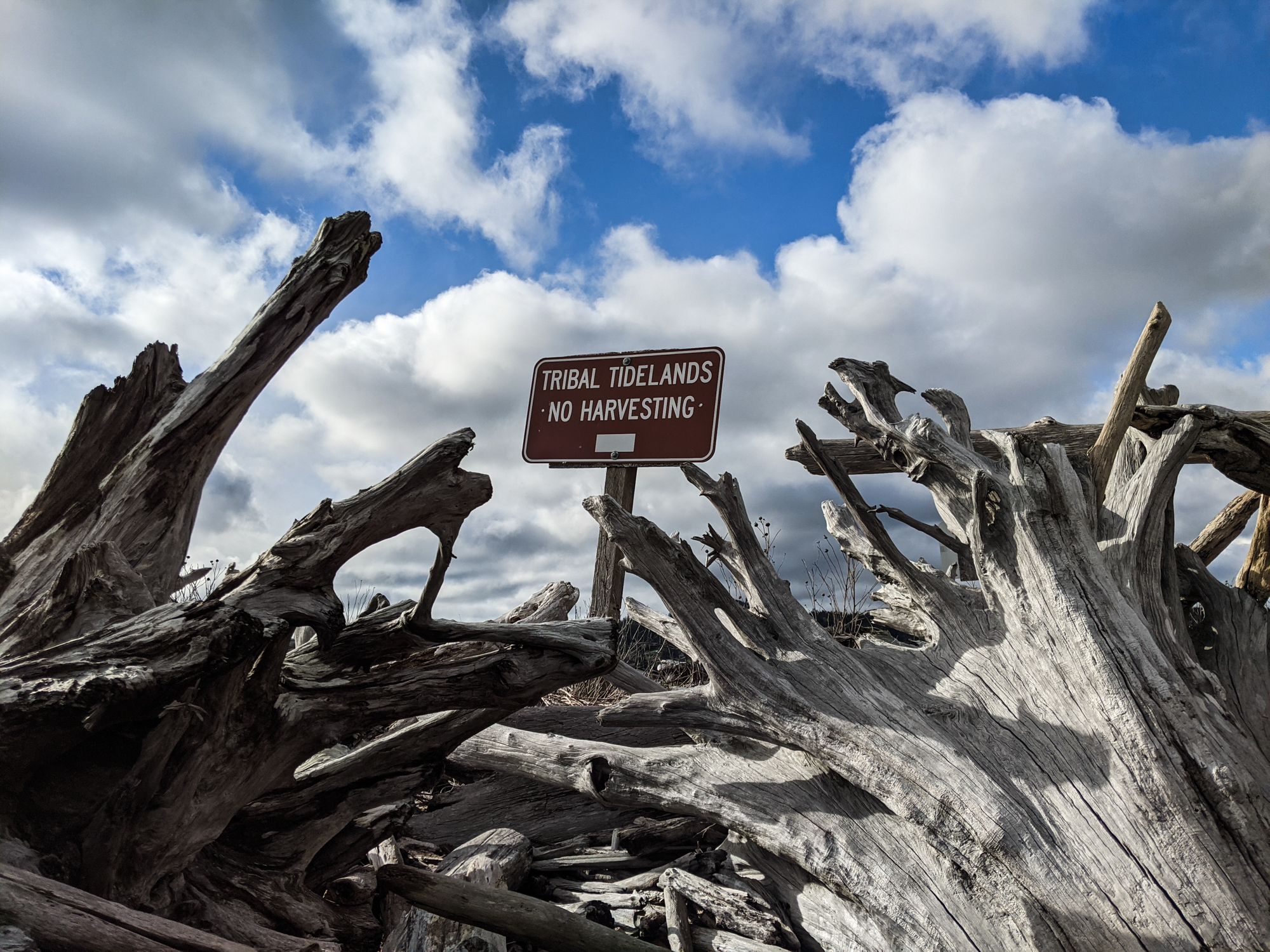
The Swinomish Indian Tribal Community retains ownership of the Kukutali Preserve’s shores, where only tribal members can harvest clams with a permit. (Photo by Nathan Abrams)
Campbell sees this work as another arm of the Swinomish adaptation to climate change. Given that the IHI framework of health acknowledges the interconnectedness of the people and the land, a changing climate necessarily impacts the whole health of the community. Campbell feels that solutions to these challenges can be found in traditional Swinomish lifeways.
“I always say that when you look at the problems that we’re dealing with today, the dysfunctions are not ours,” Campbell said. “They don’t originate from our communities, our tribal upbringing.”
Campbell champions the revitalization of traditional foodways as particularly vital work. The tribe has undertaken recent efforts toward increasing access to their traditional foods through their traditional land stewardship practices. At the Kukutali Preserve, a park co-managed by the tribe and Washington state, several of such projects are now underway.
Camas, a starchy bulb with a vibrant purple flower, was once a staple of diets for many Coast Salish peoples. Camas’s meadow habitat has traditionally been maintained with controlled burns. Today, just one small patch of camas has been identified on the Swinomish reservation at the distant edge of the Kukutai Preserve on Flagstaff Point. It has been fenced off from public access so the tribe can protect and study the plant, with an eye toward reintroducing the plant into the community.
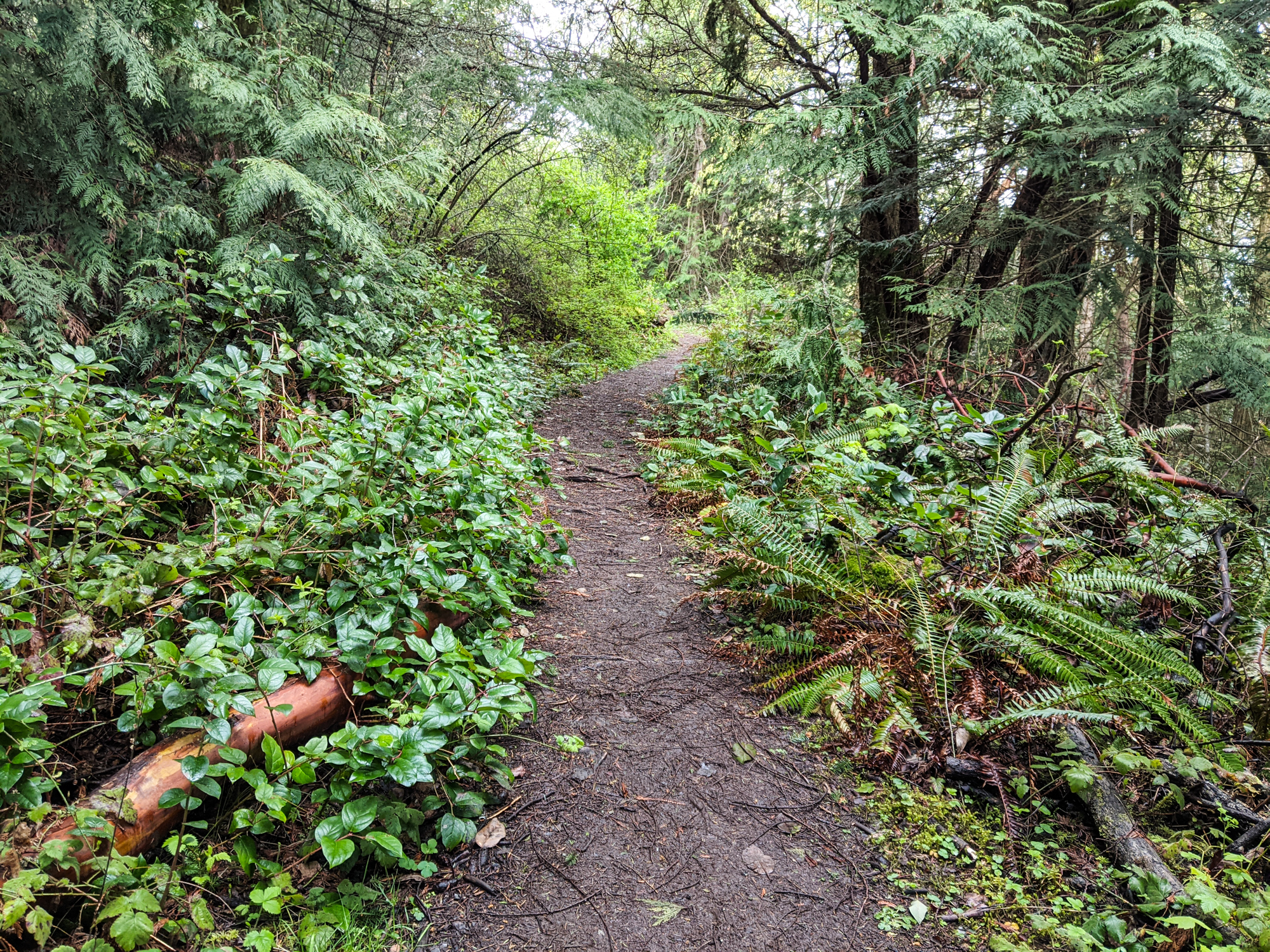
The Swinomish reservation’s upland areas are lush temperate rainforest. The mile-long Kiket Trail leads across the Kukutali Preserve to the tribe’s protected camas field at Flagstaff Point. (Photo by Nathan Abrams)
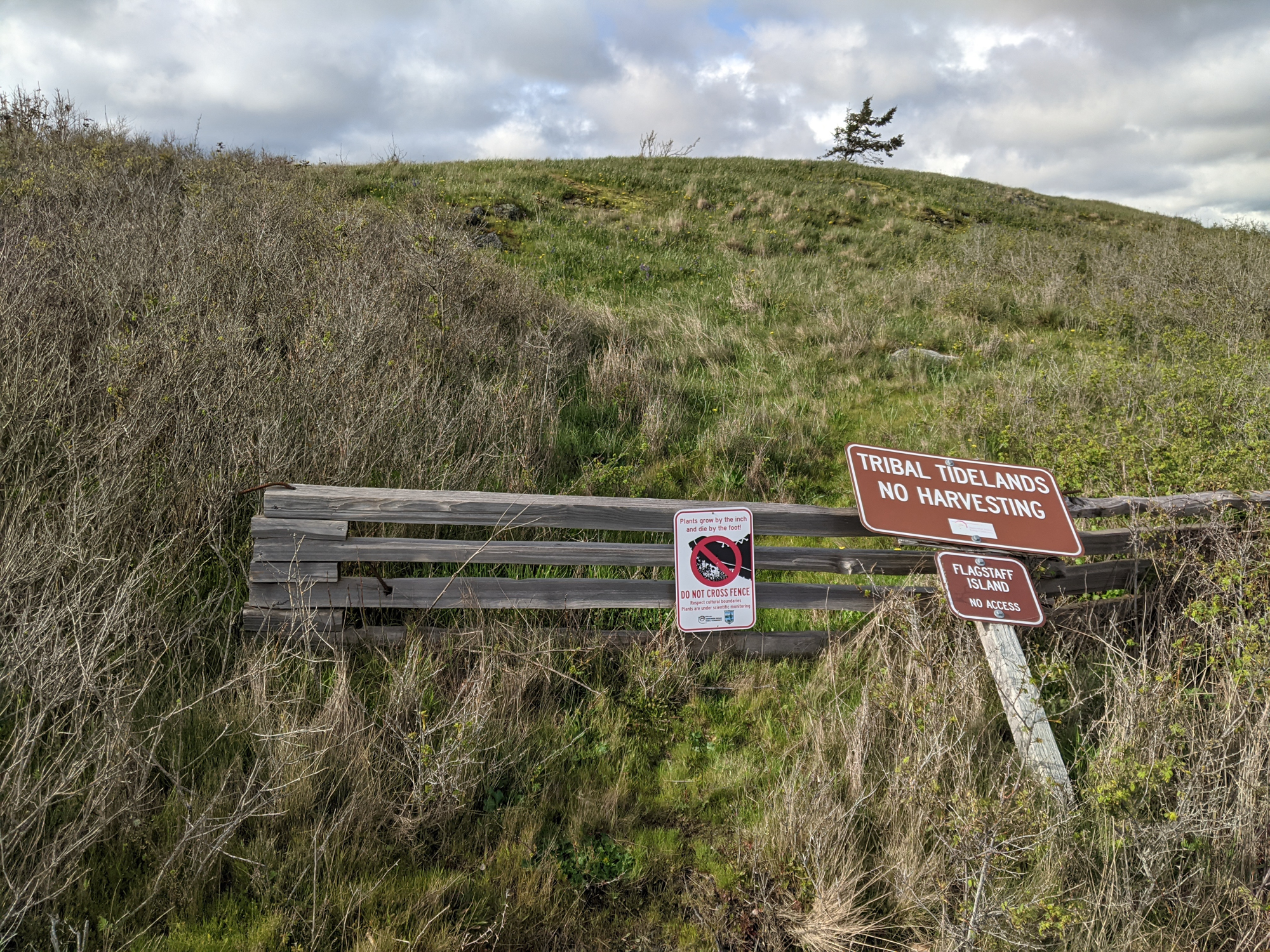
The tribe has blocked off this area at Flagstaff Point on the Kukutali Preserve to research and revitalize the local, critically endangered camas population. Meadow habitat such as this was traditionally maintained through controlled burns. (Photo by Nathan Abrams)
Swinomish people also have a deep history of mariculture. Many of their traditional foods, such as salmon, crab, and clams, come from the sea. As with camas, there is a longstanding history of ecological relationship and management within Swinomish tradition. The tribe is now planning to build a clam garden, a rock wall in the intertidal zone, along the shore at Kukutali Preserve to increase clam habitat on their reservation and reintroduce this practice into the community.
“When we eat those foods today, a lot of times our body craves it,” Campbell said. “We’re feeding our spirit by eating our traditional foods.”
Swinomish people have always adapted to and stewarded their environment. In Campbell’s holistic health framework, environmental and community healing must be approached as one. Nourishing the land nourishes the people in turn.
“Having pride in yourself as a people has wonderful healing qualities.”

ACKNOWLEDGEMENTS:
The Next Generation Radio Project is a week-long digital journalism training project designed to give competitively selected participants, who are interested in radio and journalism, the skills and opportunity to report and produce their own multimedia story. Those chosen for the project are paired with a professional journalist who serves as their mentor.
This edition of the #NPRNextGenRadio project was produced in collaboration with:
- Managing Editors – Michelle Faust Raghavan - Independent Editor, Portland, Oregon; Phyllis Fletcher - Independent Editor, Seattle
- Digital Editors – Alexis L. Richardson, Chief Innovation Officer/Digital Content Strategist, Philadelphia; Lita Beck (Navajo) - Senior Politics Editor, The Philadelphia Inquirer; Heather C. Gomez (Jicarilla Apache) - Freelance Digital Editor, Dulce, New Mexico
- Audio Tech – Selena Seay-Reynolds - Freelance Audio Engineer, Los Angeles; Abby Fritz, Freelance Audio Tech/Producer, Syracuse, New York
- Editorial Illustrators – Lauren Ibañez, Freelance Editorial Illustrator, Houston; Eejoon Choi - Freelance Editorial Illustrator, Los Angeles; Ard Su - Freelance Editorial Illustrator, New York
- Visuals – Todd Michalek, Freelance Visual Journalist, Syracuse, New York
- Web Developer – Robert Boos, Freelance Creative Technologist, Minneapolis
Our journalist/mentors for this project were:
- Pauly Denetclaw - Politics Reporter, Indian Country Today, Albuquerque, New Mexico
- Savannah Maher - Reporter, Marketplace, Albuquerque, New Mexico
- Taylar Stegner (Shoshone and Arapaho) - Tribal & Rural Reporter, Wyoming Public Radio
- Tarryn Mento - Reporting Fellow, WAER, Syracuse, New York
- Carrie Jung - Education Reporter, WBUR, Boston
NPR’s Next Generation Radio program is directed by its founder, Doug Mitchell.
